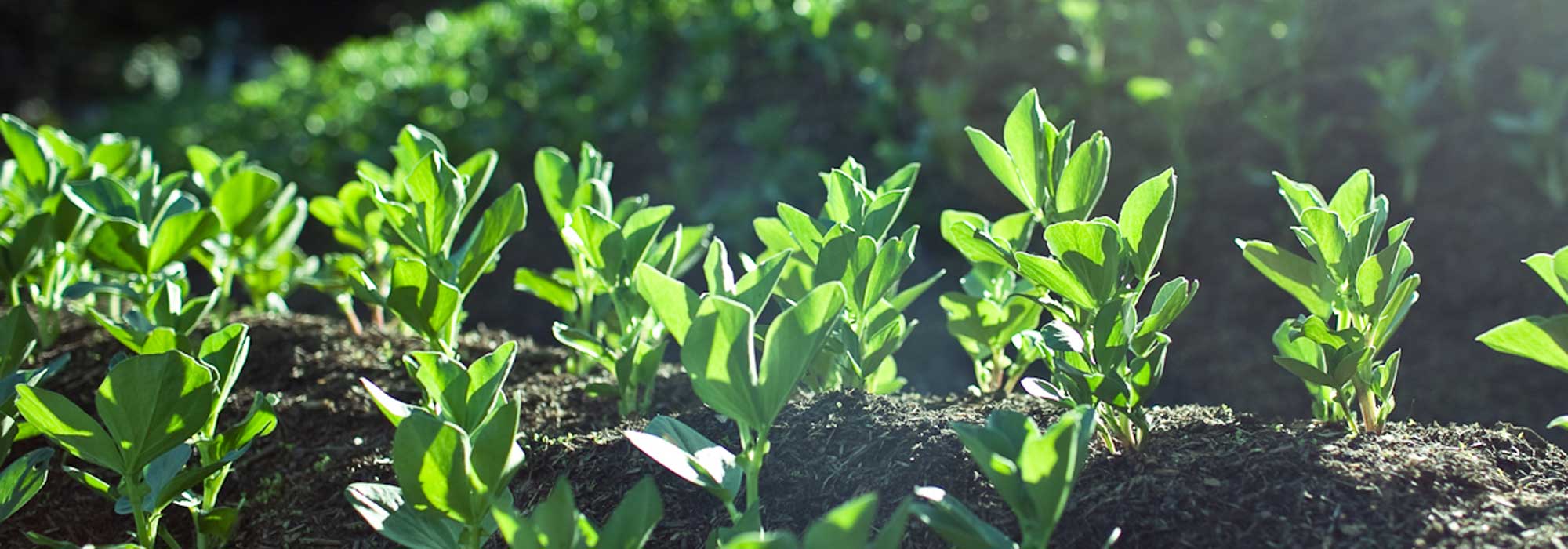
Broad bean: to sow, to grow, to harvest
Contents
Broad bean in a nutshell
- Broad bean is a vegetable that belongs to the large Fabaceae family, and it is a soil-enriching plant.
- It is an undemanding vegetable that prefers fairly heavy but deep, humus-bearing, slightly calcareous, moist soil. It grows in sunny exposure.
- Broad bean is cultivated by sowing in autumn or spring for a harvest from May to August.
- The black bean aphid is a common problem for which natural solutions should be prioritised and are easy to implement.
- The seed is rich in proteins and energy nutrients, it is considered a starchy food and is most often consumed as fresh broad bean, either raw or cooked.
The word from our expert
The broad bean is a vegetable widely grown around the world for both its flavour and its nutritional qualities, particularly its high protein content. It is still highly appreciated as it is the first fresh seed-vegetable of spring. Indeed, its harvest can begin before that of the pea, as early as the end of April in the regions most favourable to its cultivation (Mediterranean climate).
In the vegetable garden, growing broad beans is simple; their large seeds germinate easily with autumn or spring moisture, and they even thrive in heavy, calcareous soils. It is advisable to avoid growing them in heather soil, as they do not like acidity! There are various varieties, the most common being ‘Aguadulce’, a vigorous variety with strong growth and good productivity, producing long pods that contain 8 to 9 seeds. However, it does require earthing up and staking. If you are new to gardening, opt for varieties that do not require earthing up or staking, such as ‘The Sutton’ or ‘Robin Hood’, two dwarf varieties that reach 30 – 35 cm in height and still produce numerous pods.
Don’t hesitate to (re)discover the taste of fresh broad beans, and try them simply raw, with a sprinkle of salt; you won’t regret having grown them!
Description and Botany
Botanical data
- Latin name Vicia faba var. faba
- Family Fabaceae
- Common name Broad bean
- Flowering Annual
- Height 5 years
- Exposure Sun
- Soil type Clay dominant, deep, moist, slightly calcareous
- Hardiness Hardy
Broad bean, one of the first foods of humanity, originates from the Near East, where remains dating back to 6000 BC have been found. It is believed to have been cultivated in various locations around the Mediterranean from 5000 BC until the Bronze Age (Greece, Portugal, Italy). During the Middle Ages, it was widely cultivated in Europe and arrived in America in the early 17th century. It is grown for the vegetable, the broad bean, but also to make flour. Traditionally, it was a broad bean that was hidden in the galette des rois, with the porcelain bean arriving at the end of the 18th century.
The broad bean, Vicia faba var. faba, is a herbaceous annual plant from the Fabaceae family. The genus name, Vicia, comes from the Latin vincio meaning to bind or tie, due to the presence of tendrils on the plant that allow it to cling to neighbouring plants. The species name, faba, refers to the broad bean and is also found in the family name (Fabaceae).
The plant is robust, with a upright habit, forming stems that can exceed one metre in height. The leaves are composed of 1-3 pairs of large, ovate, succulent leaflets. The plant forms short, simple tendrils. The flowers, grouped in clusters of 2 to 5, have a white or pink corolla with black spots, and are of papilionaceous shape. The fruit is a pod that contains flattened seeds, which are surrounded by a thick skin, the integument. There are many varieties, with pod size and seed colour varying from white, green, red to brown.
Finally, it is interesting to present the root system of the broad bean: it consists of a main root from which many lateral roots emerge. Legumes like the broad bean have the ability to live in symbiosis with bacteria, rhizobium. This symbiosis is observed by the presence of nodosities on the roots, which are small spherical outgrowths called nodules. This symbiosis allows atmospheric nitrogen to be made assimilable to the plant. Indeed, atmospheric nitrogen (about 80% of the atmosphere) is in a very stable form, impossible for the plant to assimilate. The Rhizobium have the ability to transform this nitrogen and make it assimilable for the plant. In exchange, the rhizobium also gain from this symbiosis, receiving a carbon substrate (sugar) from the legume.
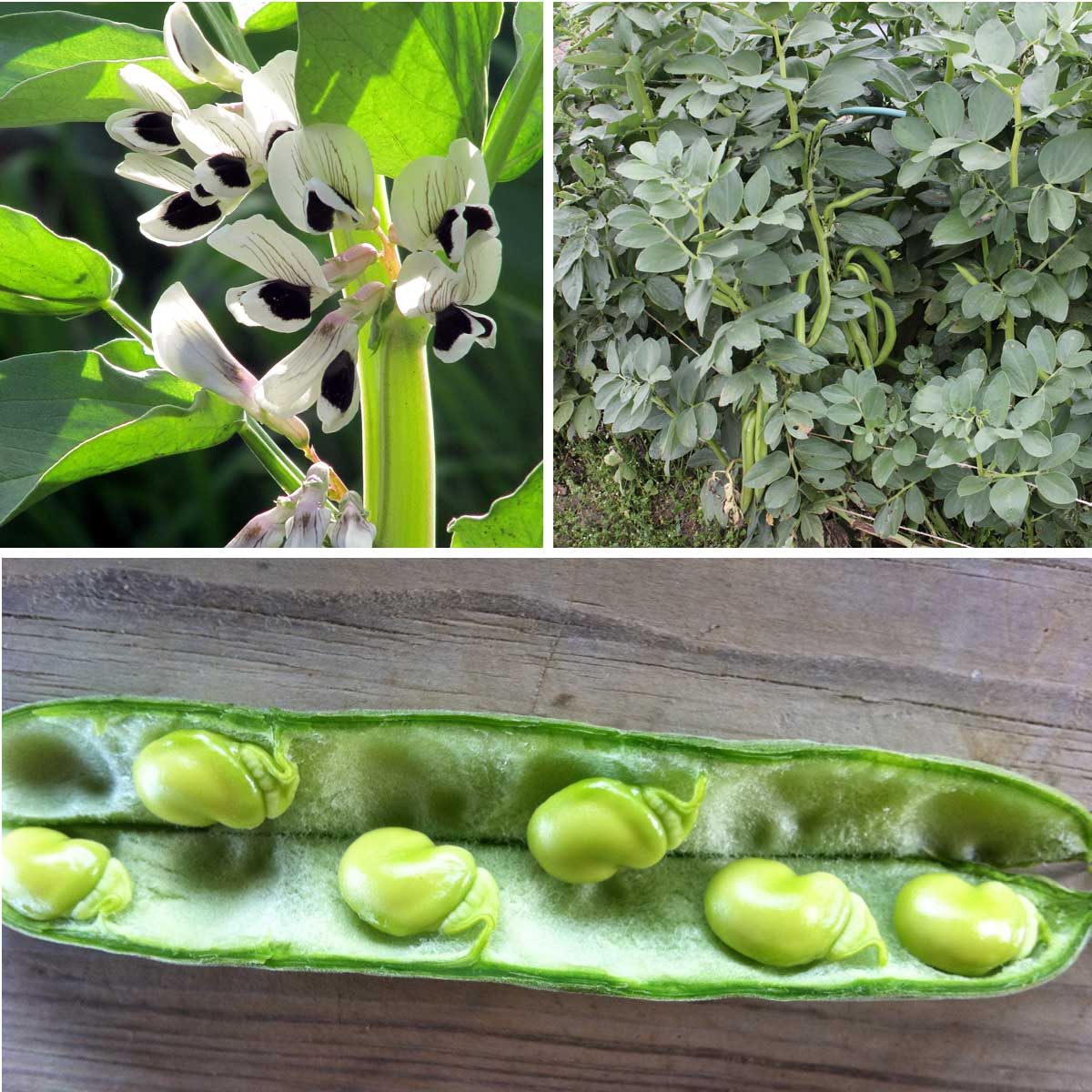
The papilionaceous flower of the broad bean – Pods on the plants – Open pod with the beans
Varieties of broad beans

Broad bean Aguadulce - Ferme de Sainte Marthe seeds
- Height at maturity 1 m
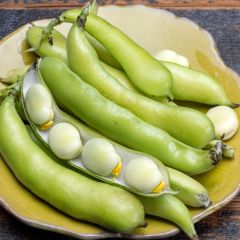
Broad Bean Threefold White
- Height at maturity 1 m
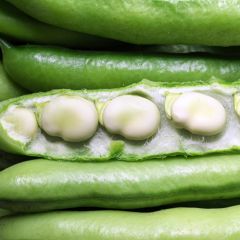
Broad Bean White Extra Early
- Height at maturity 1 m

Broad bean Express
- Height at maturity 90 cm
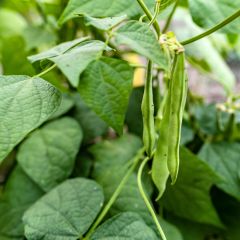
Broad bean The Sutton
- Height at maturity 30 cm
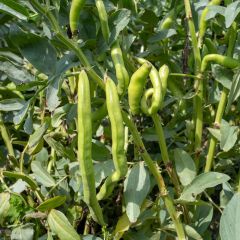
Broad bean Seville Long-Pod - Vilmorin seeds
- Height at maturity 1 m
Discover other Broad Beans
View all →Available in 1 sizes
Available in 1 sizes
Available in 1 sizes
Available in 1 sizes
Available in 1 sizes
Available in 1 sizes
Available in 1 sizes
Available in 1 sizes
Available in 1 sizes
When and how to sow broad beans
Where and when to sow broad beans?
Sowing broad beans takes place at different times depending on the regions:
- from late October to late November in the South, under mild climate (Brittany, seaside) or under cover elsewhere for a harvest from mid-May to late June.
- from early February to late April in the rest of France, for a harvest from mid-June to late August.
Young broad bean plants tolerate negative temperatures but cannot withstand several days at -5 °C. If you are sowing in winter or if the end of winter is icy, consider sheltering them under a Nantes tunnel.
How to sow broad beans?
Germination of broad beans occurs at a minimum temperature of 8°. Emergence takes between 8 and 30 days, depending on the temperature.
Before sowing, prepare the sowing bed by loosening the soil with a broad fork, weeding, and levelling with a rake and hoe. It is a low-maintenance vegetable that is satisfied with the remaining nutrients from a demanding crop, so fertilisation is unnecessary.
To sow:
- Draw furrows spaced 40 to 50 cm apart, with a depth of 3 to 4 centimetres.
- Sow in rows, spacing the seeds 5 cm apart and cover with soil.
- Firm the soil and water if the soil is not sufficiently moist.
To grow, maintain, and companion plant the broad bean
Growing broad beans is easy if your soil is clayey, deep, moist, and slightly calcareous. It does not like acidic soils. Like all Fabaceae, it is not demanding, so there is no need to add organic fertilisation. It will be satisfied with the remnants of a demanding crop, for example after tomatoes.
Its maintenance is simple, consisting of weeding and earthing up regularly as the plants grow. Earthing up stimulates the formation of new roots and ensures better stability. At flowering, traditionally, the top of the plant is pinched (cut off with a knife, pruning shear, or between two fingers) to encourage pod formation.
It is sometimes necessary to stake the broad beans if earthing up is not enough to keep them upright. For this, place a stake at each end of the row, plus intermediate stakes depending on the length of the row. Join the stakes with a string to keep the plants upright.
In terms of companion planting, broad beans are good neighbours, they promote the growth of cabbage and lettuce.
To deter aphids, you can also sow phacelia and rocket between the rows of broad beans. In mild climates, rocket (cultivated) should ideally be sown in autumn. In spring, it will flower and attract a myriad of beneficial insects with its nectar. Their presence will be useful to counter the first black aphids on the broad beans.
Pests of the broad bean
The black bean aphid
The bean is the preferred vegetable of the black aphids (Aphis fabae). They appear in April and May and quickly form large colonies that can harm the production and quality of the pods. They can also lead to cryptogamic diseases on the plants, such as sooty mould.
To dislodge them without resorting to insecticides, you can spray water mixed with black soap (2 tablespoons per litre) or, more simply, use a water jet to knock them off. However, I recommend other more natural approaches.
Other approaches to regulating black aphids without treatments:
In a natural vegetable garden, that is to say with refuges, wild areas, and simple natural flowers, one can appreciate the presence of beneficial insects such as ladybirds, hoverflies, lacewings, and parasitic wasps, etc. This diversity of auxiliaries is generally sufficient to fend off the initial attacks of black aphids.
In an organic vegetable garden, without natural areas as in the previous case, look for ladybirds and move them onto the beans where the black aphids are present.
Finally, as mentioned above, encourage spring flowering such as sowing rocket in the autumn.
→ Learn more with our advice sheet Diseases and pests of the bean
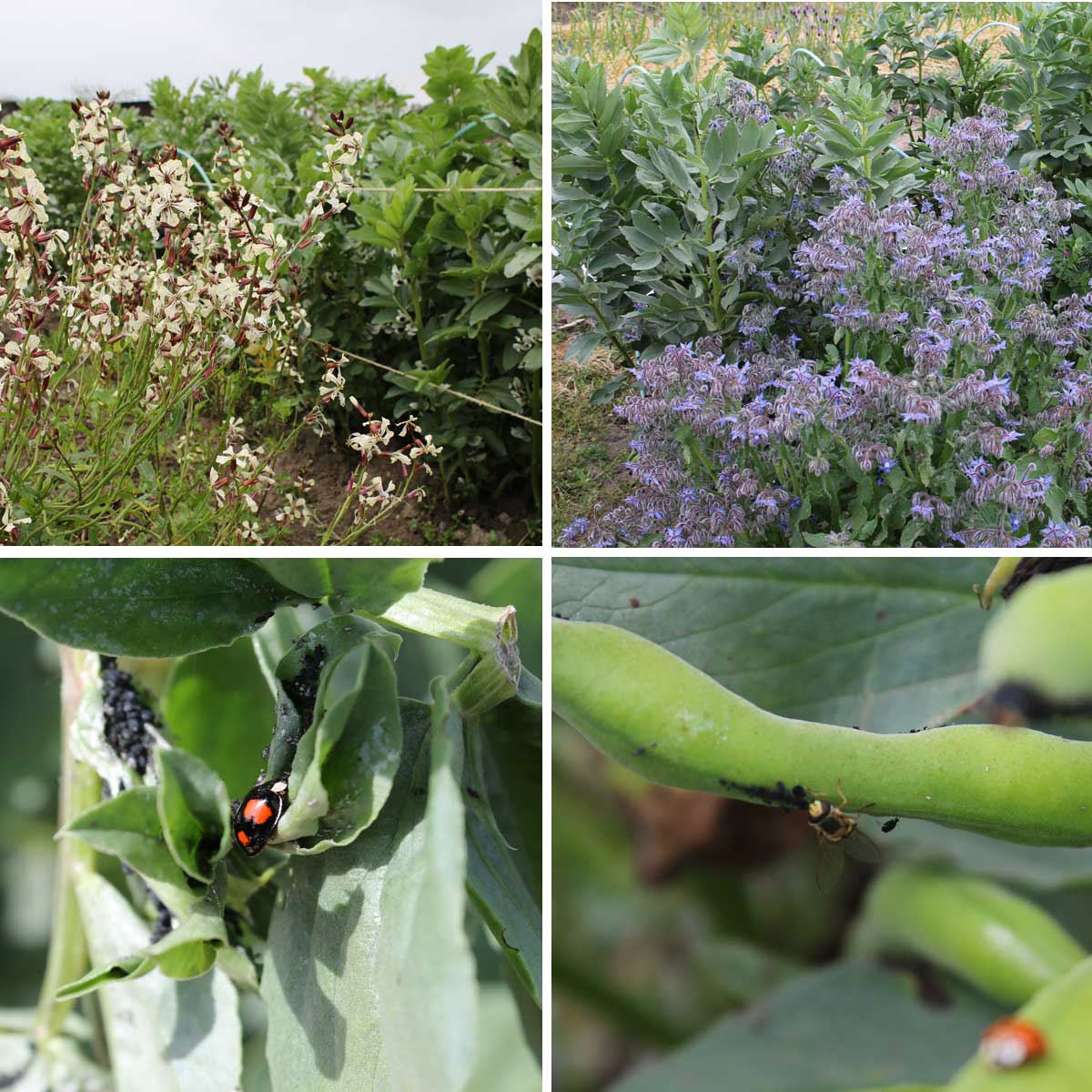
Allowing rocket and borage to flower near the bean attracts beneficial insects in spring, starting in April. – An Asian ladybird feeds on black aphids – An adult hoverfly has likely found a place to lay its eggs, and the larvae will feed on the aphids.
The bean weevil
The bean weevil Bruchus rufimanus is a beetle that completes its larval cycle inside the beans. At the pupation stage, clear circular holes can be observed in the beans, rendering the seed inedible. This is a real problem in two cases: during seed production and for the consumption of dried grains. A simple and effective solution exists to kill any larvae: once the beans are ripe, they should be harvested without delay and placed in the freezer for at least 24 hours. It is important to carry out this operation as quickly as possible to stop the larval development of the weevils, which lasts three months, inside the beans.
→ Learn more in our article: What is the legume weevil? How to get rid of it?
Harvesting and storing beans
The harvest of broad beans begins in May, in mild regions, for beans sown in autumn. For spring sowings, the harvest starts in June. The harvest occurs at different stages of ripeness, which vary depending on how you wish to consume them: young pods whole, fresh beans in still green pods, or dried beans at full ripeness.
Fresh beans can be stored for a few days in the vegetable drawer of your refrigerator or they can also be frozen very well. Dried beans can be stored for at least a year. It is important to place them in the freezer for at least 48 hours to kill any potential eggs and larvae of weevils.
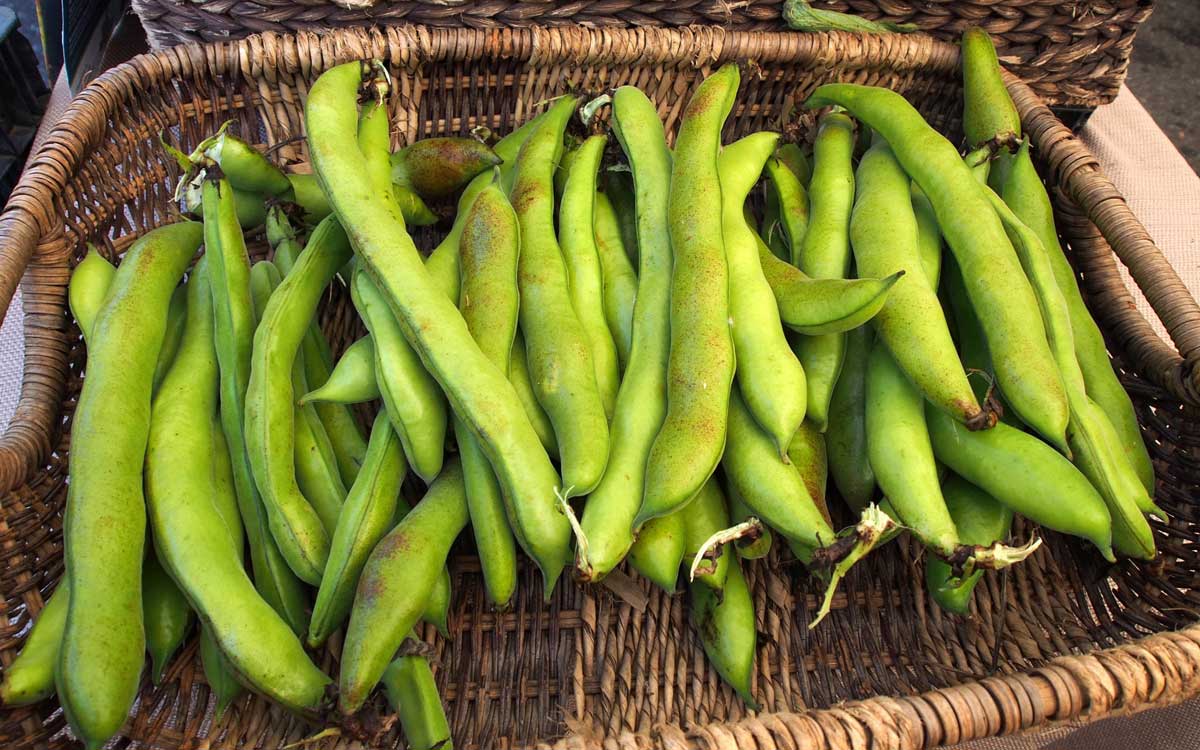
Uses and nutritional benefits
Broad beans can be consumed both raw and cooked. Preparing fresh broad beans takes time; first, they must be shelled and then skinned, which means removing the second skin that surrounds each seed, known as the integument. This operation is made easier by blanching the beans for a few moments in boiling water. To enjoy them raw with salt like radishes, they should be harvested young, which allows for skipping the second peeling. Generally, 1 kg of raw broad beans yields about 250 g of peeled beans.
To consume dried broad beans, soak them overnight in three times their volume of water, then cook them for 1.5 hours. After cooling, peel them before cooking.
As we have seen, broad beans are a legume and are rich in protein; in fact, they are the legume with the highest protein content, at around 25%. They also contain vitamins C, E, and B, which help the body better assimilate proteins. Additionally, they have a good content of complex carbohydrates, particularly starch. Finally, they are rich in trace elements, iron, and magnesium.
Broad beans have excellent nutritional benefits, particularly their richness in protein, which can replace animal proteins. Their consumption fits well within a vegetarian or vegan diet, as well as serving as a recovery food for athletes.
Useful resources
Discover in our shop our range of broad bean seeds.
Two interesting books to delve deeper:
In the garden: I Grow Peas, Broad Beans, and Beans by Blaise Leclerc, published by Terre vivante, 2013
In the kitchen: Do You Know How to Taste Dried Vegetables? by Bruno Couderc, Gilles Daveau, Danièle Mischlich, and Caroline Rio; photographs by Kim Jonker, published by Presses de l’EHESP, 2014
Frequently asked questions
-
The leaves and pods have brown spots, what could it be?
Such symptoms, namely brown spots appearing on leaves, stems, pods, and even on the integument of the bean, are often caused by anthracnose, a fungal disease that can occur in cases of excessive moisture. My advice: promptly remove the affected parts and spray a horsetail decoction on the rest of the crop.
-
How to peel broad beans?
Unlike beans or peas, it is preferable to shell the broad bean to consume only the best part. Once the broad beans are separated from the pod, the thick skin, that is to say the integument, surrounding the rest of the seed must be removed. This process is referred to as "de-robbing" the broad beans. However, if the pods are harvested at an earlier stage, the integument remains quite thin and there is no need to de-rob.
-
Every year, my broad beans are infested with black aphids, what should I do?
Black bean aphids are a common problem that does not necessarily require intervention from the gardener (see above). However, if you wish to get rid of them, you can spray your young plants with a solution of water and black soap (2 tablespoons of soap per litre of water). Repeat the operation if necessary.
- Subscribe!
- Contents
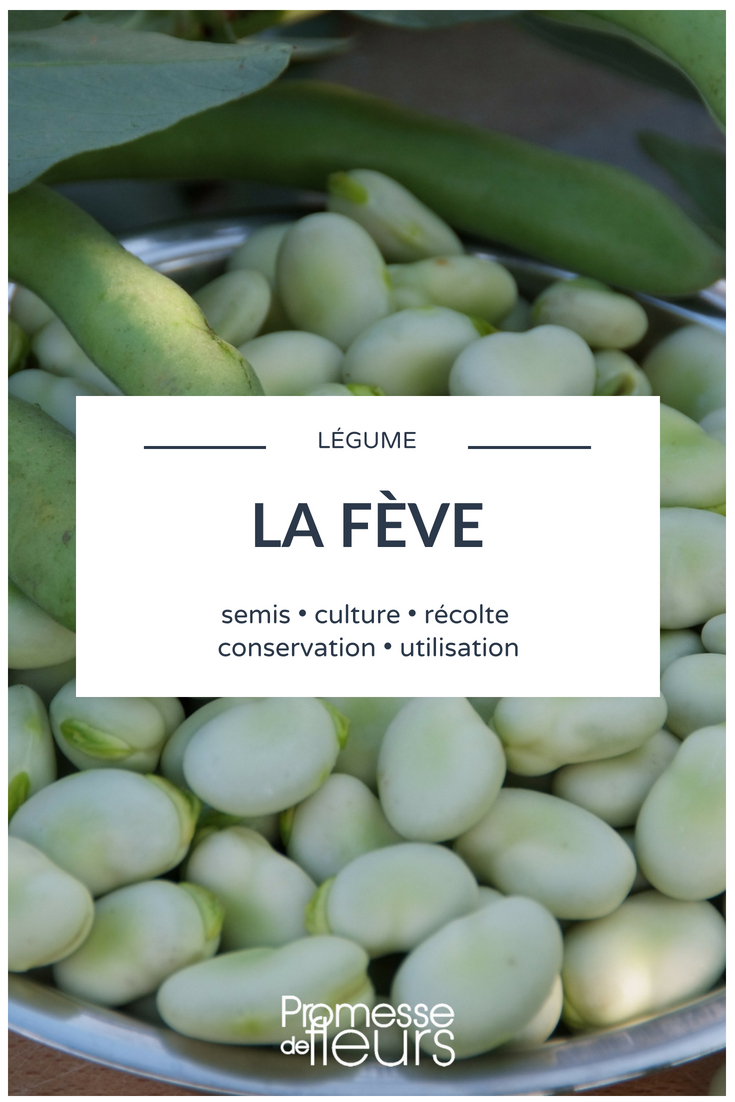


































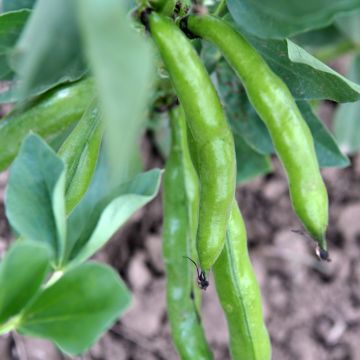




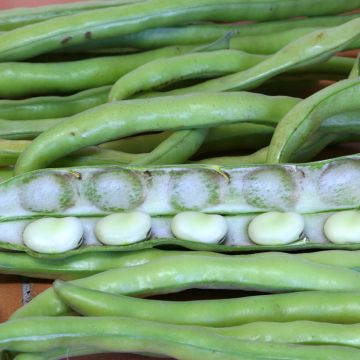
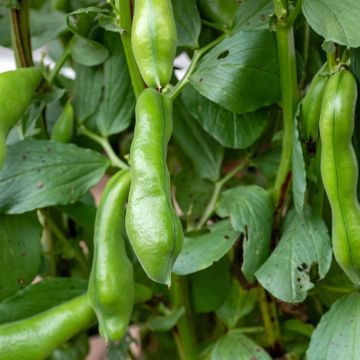
Comments